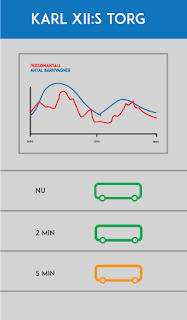We started off right from the beginning when defining our target-groups. Continuing forward towards doing our field-study with the method of using short interviews and a questionnaire that gathered qualitative data. By then we had the main key takeaways when observing our target-group which were the following:
- generally negative to being interviewed
- they all own a smartphone
- positive to waiting for the next bus, if they knew it had more space
- negative attitude from other travelers towards our target-group
A short summary was made on when we used us by the method of creating personas and putting them into scenarios. The main conclusion was that we it helped us to think from a new perspective and also identify weak spots by asking ourselves the question, "What's their reaction and problems in the scenarios?".
Going back to our early sketches onward to the low-fi prototype to finally designing the hi-fi prototype, we could even more reflect on our process. We considered the process itself to be a short amount of time and we had quite a slow start. Brainstorming our ideas even further could've helped us as a group to find more motivations in our idea. When working on a target group based on the same amount of people as our own group, a lot of the work were based on assumptions about our target group.
So for starting prototyping our design, it's hard to imagine to do it any other way than we did. The peer-feedback gave us improvements on the small details on colors or symbols and not the general iterating throughout the application.
But using the evaluation methods we were given, such as doing a walkthrough, usability heuristics and think-alouds , it became clear that improvements were made every time we iterated. And the more technology we implemented, we would've need to do another iteration and that feedback would've been even more valuable for our product. This was the most important key takeaway for our group from our process.
The development of our design process:











